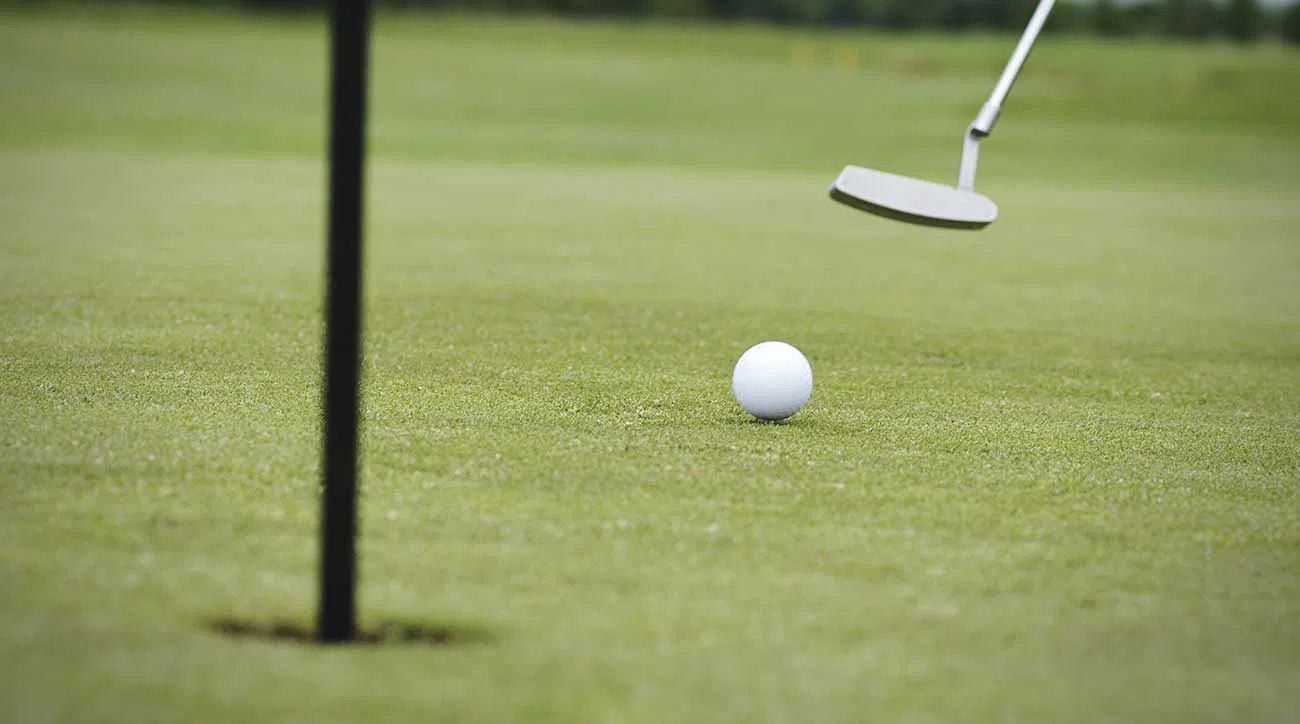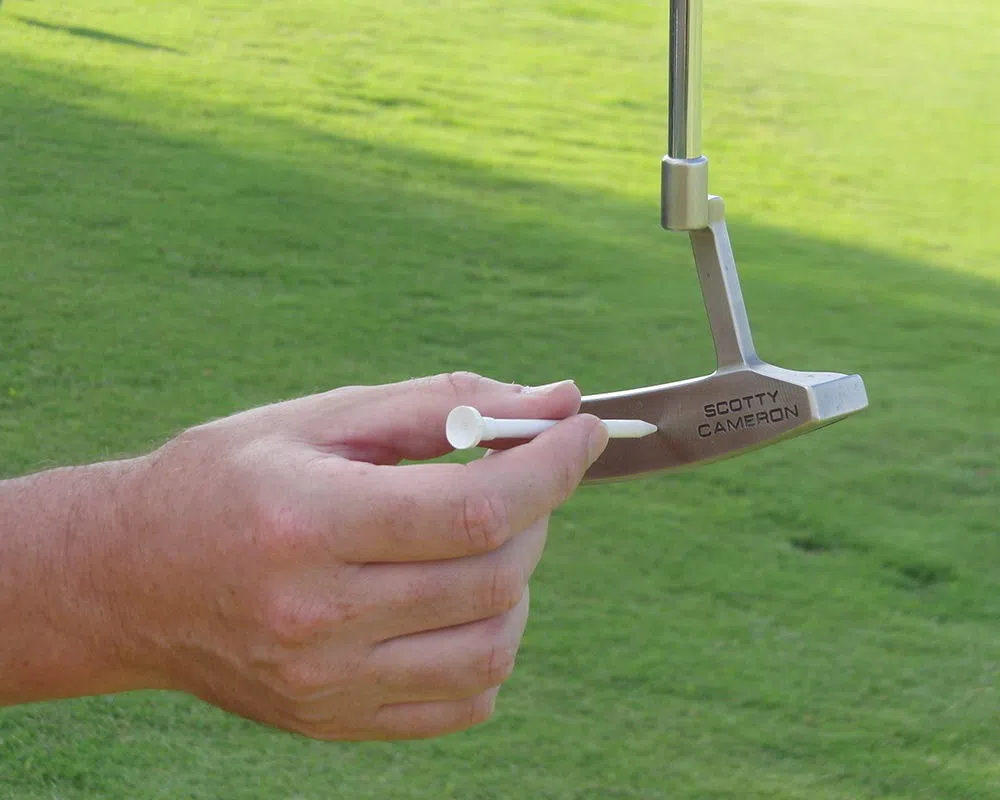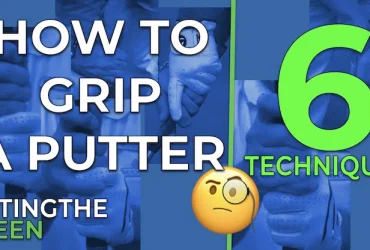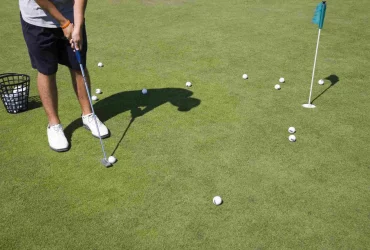Putting Tips

How often do you practice your stroke, alignment, changing your grip, or even having a putting lesson? Never thought of it? – In that case, “Take a lesson” is probably one of the best tips I could give you, so follow these few steps below.
These are the more important golf putting tips you need to follow. Do think seriously of having an instructor or an experienced golfer teach you how to perform the putt hands on, as you will learn faster from a person than carrying a book of golf putting tips out onto the practice course with you but do keep these tips in mind at all times.
Contents
- 1 Don’t forget “Ball Position”
- 2 Work on your Short Putts first
- 3 Eye on a Dime
- 4 The “Eyes Closed” Trick
- 5 The Bullseye Trick
- 6 Keep your head still!
- 7 Rhythm
- 8 One-handed practice stroke
- 9 Sweet spot
- 10 Use the toe of the putter on downhill putts
- 11 Putt to the “High Side” of the Cup
- 12 The putt stopper
- 13 Try to push through the ball
- 14 Your Eyes are the key to the best Putt
- 15 Don’t Grip too tightly!
- 16 Read the speed of the greens
- 17 The right line
- 18 Arms, shoulders and wrists
- 19 Body position
Don’t forget “Ball Position”
An important factor in golf is the ball position. Don’t forget it is the back of the ball that you’re stroking with the putter, and not the centre. It’s a good idea to teach yourself that the back of the ball is in the middle of your stance, or slightly forward of this, if you are using a square-to-square stroke.
Work on your Short Putts first
If you need to improve you short putts, one of the best putting tips I have found is to “putt to a dime”. – It’s a great way to improve focus and concentration levels! Use a small dime or any other coin (smaller the better) and putt the golf ball toward it. When you get the hang of this you will find it much easier when the target is a larger hole in the ground. Another great putting tip is to sink five in a row from a one foot distance, then from two feet distance, and then three feet, you get it? If you miss one you have to go back and start over and don’t move up in distance until you get all five. This should improve you putting accuracy at least three or four fold!
Eye on a Dime
Place a dime or any other coin behind the ball, and then keep your eyes focused on the coin all through your stroke. Do not give in to the urge to follow the golf ball with your eyes after the putter impacts the ball, especially on shorter putts. Just maintain you eye focus on the coin rather than following it’s path with your eyes head and shoulders.
The “Eyes Closed” Trick
The “eyes close” putting technique is well known throughout the golfing community.
Q. What exactly is accomplished when golfers close their eyes on golf putts?
A. Michael Lamanna, Director of Instruction at The Phoenician in Scottsdale, Ariz, says, “There are many examples of tour players who have struggled with their stroke and have resorted to these techniques. For instance; when a golfer loses confidence in their performance on the golf field, it is possible to relieve some of the self-doubt by focusing on the hole rather than the golf ball itself.”
Also, by closing their eyes completely. The given effect is that of a clearing of the mind, a getting away from ball-focus, from being too mechanical and allowing the well-honed “feel” of the golfer to take over.
Q. So can recreational or otherwise novice golfers use these techniques in our putting?
A. Well, it’s not usually a good idea for a recreational golfer to close their eyes during play. Most of us have enough trouble with our eyes open! But there are ways to incorporate the eyes-closed technique in your practice routines that can help you develop better feel in your putting stroke or in your full swing.
The Bullseye Trick
Three-foot putts or more can really mess with your head if you let them. A really good golf putting tip to solve this is to imagine a bullseye attached to the back of the cup. This then encourages the player to accelerate the putter through to the hole and maintain the clubface’s movement square to the hole. This technique is used and recommended by one of the all time great putters, Seve Ballesteros.
Keep your head still!
Keeping your head still is very important for solid contact with the golf ball and consistent putting. Try focusing on keeping your head still even after the golf club has hit the ball. Players who move their head to soon after contact with the ball are known to move their heads earlier and earlier every time and eventually move their head before the golf club strikes the ball, thus losing a shot.
Early head movement also causes the player’s shoulders to open and results in the putter cutting across the ball and makes the golf ball travel in the wrong direction. Also, try the “eyes closed” putting trick in conjunction with this tip. You will be amazed!
Rhythm
I’m sure you’ve noticed the stroke a professional makes. It’s so smooth and in sync. This type of stroke eliminates any jerk motions that will lead to bad impact and a whole heap of bad outcomes on your shot.
A good way to learn to be in sync in your stroke is to use what’s known as a metronome. A metronome is any device that produces a sound in a rhythm. A clocks tick is a metronome, so use that. Simply place the clock next to where your taking your shot and practice by swinging to the rhythm of the “tick” “tock” sound. On the “tick” your putter should be at the top of its backswing, and on the “tock”, it should have arrived at the end of your follow through. Slow, rythmical and unhurried.
Now, once you’re used to the rhythm of your putt, simply apply it your shot. Remember the tick tock as you stroke and your putting will improve, trust me!
One-handed practice stroke
Some players like to feel confident in their leading hand on a putt, and Tiger Woods often practices with just his right hand to promote familiarity and feel with his lead putting hand. Whatever hand is your lead hand in a stroke, practicing with it will increase your confidence in your putting as it will produce a pure putting stroke.
When doing this with one hand it’s going to feel a little strange to begin with, but as you continue to practice you’ll come to realise its very natural. Practice at lengths, and don’t be scared of applying a little wrist action into it, as it will produce a pure stroke and a true roll of the golf ball. Make sure that you stay tension free and loose as this will produce the best results.
Sweet spot
One common characteristic with tour pros is they all produce consistent ball striking, which is a product of the centre of the club face, or the sweet spot, hitting the ball. Hitting the ball in the centre of the clubface produces a good roll and a consistent speed. Putts that are hit on the toe or the heel of the putter face will veer offline. So to combat this and to train yourself to hit the ball in the centre every time there is a technique that helps a lot.

You should wrap two rubber bands around your blade so that they straddle your putter’s sweet spot. When you feel confident that you can consistently hit the centre of the putter face every time, you can take them off and try to continue it. If you start to feel a change in the contact quality, then it’s time to replace the rubber bands and continue the technique until you become confident again.
Use the toe of the putter on downhill putts
It is well known that downhill putts can be fast and difficult. Try this technique performed by many pros: Hit the ball with the toe of the putter, not the sweet spot. This tends to “deaden” the jump on the ball and stops it from going way past the hole. But refrain from performing this trick on uphill putts!
Putt to the “High Side” of the Cup
When about to perform breaking putts, professional golfers will almost always favor the “high” side of the hole rather than the “low” side. It is common knowledge among golfers of all ages and skills that as a putt is breaking near a hole, gravity works in your favour if the ball is above the hole.
However, if the ball is breaking away on the “low” side of the hole, gravity will then be working against you. Remember: “It’s the pro side not the low side!”
The putt stopper
All great putters use a backswing and follow through of the same length. This allows for increased acceleration through the ball and it also helps to control the distance of the shot as well. One very common error I see with players is they swing too far back and then slow down there stroke at impact. This causes inconsistency in distance and accuracy. Always remember to stroke through the ball instead of at it!
Try to push through the ball
On the stretch, one thing you don’t want to happen is to find yourself uncomfortable over a short putt. Yips usually come from the golfer decelerating, the putter also tends to stray offline and then you’ve just missed a putt! In order to stop this you must practice a simple exercise to help instil mechanics of a more efficient style at the hole.
First, place golf balls from one foot to about two feet from the hole, in a circle on the practice green. Stand over the ball with the putter as usual, only this time, do not use any backswing. So in short, push the ball with the putter instead of hitting it.
Hold the finish until the ball drops into the hole. Have you got it? Great, now do it from a further distance of about three-to-five feet. By doing this, you are training your body to push through the ball rather than striking it.
The professionals and most other golfers accelerate and push the ball from ten feet anyway but as you will do it from short range; you will need to maintain a steady and straight roll toward the hole.
Remember you want to make the hole not stop short of it or overshoot it so your judgment is important. When you get used to the flat terrain, try practicing on a sloped hill and putts that break left or right. Now knowing that your body is trained to accelerate, all you have to do is read the line, pick your spot and make a confident stroke!
Your Eyes are the key to the best Putt
One of the most frequently asked questions about putting is:
Q. “How do I improve the feel on lag putting?”
A. Well, in short, use your eyes! In most other target-oriented sports like basketball, the player’s eyes are almost always looking at the target while shooting the ball. On the other hand, golfers tend to glance at the target and stare at the ball. While on the practice green, try practising looking at the hole, allowing your eyes to tell your body how far to roll the ball and how much acceleration it needs.
When you are putting, use the feeling that your eyes have just told you to perform the putt. Improving you feel will improve the putting performance and obviously will higher your scores. Read more on lag putting here.
Don’t Grip too tightly!
Gripping onto the putter can be done in so many ways but is is very important not to have a dominant hand on the putter while holding it. If you have one of your hands tighter than the other, this will cause the tension in your shoulders to be uneven. The shoulder to the hand that is tighter on the putter will be more tense than the loose hand’s shoulder.
Read the speed of the greens
If you try different golf courses regularly you will know that the green speeds change all the time, even if you use the same courses, the speeds can still change with weather conditions etc. It can be really frustrating when you’re not used to the speed of the greens as you know. There’s something very simple that can be done before your stroke that will combat this problem. What you have to do is exaggerate your practice stroke.
So if you’re playing on slow greens you should take a significant step back than your actual shot, and take a practice stroke from there. This will force you to get used to hitting the ball harder than usual for a much longer, powerful stroke. If you’re on a green that is a little faster than normal then you should take a step forward, closer to the hole than your shot. Then you simply go back to your ball for the shot and repeat the same stroke action.
Meandmygolf have done a fantastic video on reading the speed of the greens, see below.
The right line
Let’s assume you have worked out the line the ball should take to get to the hole by looking closely at the humps and borrows on the green. And you have decided that a right-to-left putt is required. Now imagine the line that ball needs to take and note a spot 6 inches from your ball along that line. Now all you need to do is to make sure you strike the ball so that it goes over that spot.
Arms, shoulders and wrists
In a putting stroke, use your arms and shoulders – forget about your wrists, lock them in position. Your body should remain still with no rotation or transfer of weight.
Body position
Let’s start with your position for the putt. Now, stand so that your eyes are directly over the line of which you want to hit the ball. To line up perfectly you should hold the putter loosely and directly under your eyes, as you approach the putt let gravity do the work and take it straight down.
Now, look down and make sure the putter covers the ball. If it doesn’t then move yourself back or forward until it covers it. The ideal spot for the ball to be is slightly behind the front foot.
The hands should also be forward away from the body, and the putter should be in line with the forearm. This position will promote a much smoother roll of the ball on impact.
Your hands and arms should work together and not spread apart. The further your arms and hands are apart the increased chance there is of you using your wrists, which opens up a whole variety of inconsistency. The ideal stroke should consist of just the shoulders and the arms.
For the grip, use 3 fingers on each hand and grip the putter lightly. On a scale of 1-10 of grip pressure, 4 would be best. This helps with the feel of the club and shot your taking.
And practice, practice and practice and your putting will improve and your score will improve.
Need a new putter? Take a look at our favourite putters here!
Need a bit more advice? Enjoy the video below!




